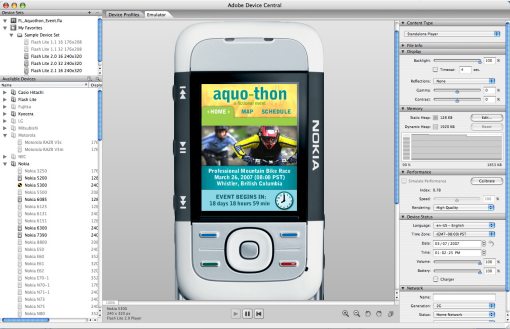Adobe's Device Central makes rich mobile development easy

 With so much media push during the CS3 release this week, it may have been easy to miss the announcement for Adobe's Device Central, an application and social community aimed at making the process for mobile development smoother. Developing mobile applications has been traditionally very difficult. Working with the variety of handsets and screen sizes posed challenges from both a user interface perspective as well as a development perspective when dealing with devices of different computing power. Flash Lite has become an increasingly popular way to create applications for devices, and Device Central aims to make it much easier for designers and developers to use CS3 tools to create great content for the mobile world.
With so much media push during the CS3 release this week, it may have been easy to miss the announcement for Adobe's Device Central, an application and social community aimed at making the process for mobile development smoother. Developing mobile applications has been traditionally very difficult. Working with the variety of handsets and screen sizes posed challenges from both a user interface perspective as well as a development perspective when dealing with devices of different computing power. Flash Lite has become an increasingly popular way to create applications for devices, and Device Central aims to make it much easier for designers and developers to use CS3 tools to create great content for the mobile world.
Adobe Device Central ties in with a lot of Adobe's flagship products, including Flash, Dreamweaver, Photoshop, Illustrator and others. There are different versions of Device Central for all of those products with a focus on specific tasks. For instance the Device Central version that ships with Flash caters to Flash designers wanting to build user interfaces. The version that ships with Dreamweaver focuses on creating great mobile web experiences. The Photoshop-focused Device Central lets you quickly and easily build prototypes. All of these tools then work together so you can quickly and easily take what you've done in Photoshop and bring it into Flash for a consistent experience across both the CS3 suite, and within Device Central itself. This provides designers and developers with a lot of flexibility in how they create rich mobile applications.
Aside from the workflow, Device Central also offers a wealth of information about individual devices. In many ways, it's an encyclopedia of what handsets are on the market and what the specifications and features are for each. Developers and designers can use Device Central's database to figure out which handsets to target depending on features. You can pick a feature, like a specific screen size you want to develop for, and then see all the handsets that have that feature. It allows developers to quickly group devices together so they can maximize their content for specific features.
Device Central also makes leaps and bounds of progress when it comes to testing content. It offers full emulation for all of the devices in the encyclopedia, including allowing the testers to modify things like battery power, signal strength, and system time. Increasingly, mobile interfaces are incorporating those attributes into interfaces. You'll see things like a background that gets darker as the day gets later or parts of the interface that actually dim the lower your battery gets. It makes the mobile experience that much richer, and it's important for developers to be able to test that. With Device Central, they have full control over the device and can make sure the interfaces and content are performing correctly.
With the number of devices increasing, and mobile content becoming an important way for brands and individuals to reach out to users, designing for the mobile world is very lucrative. Device Central is a great program to help with that, and it's one of the hidden gems of CS3. Just like the rest of the Creative Suite, Device Central really enables people to create great experiences, but this time, it's in the mobile world. See my Device Central gallery for some of the shots of the new program.
